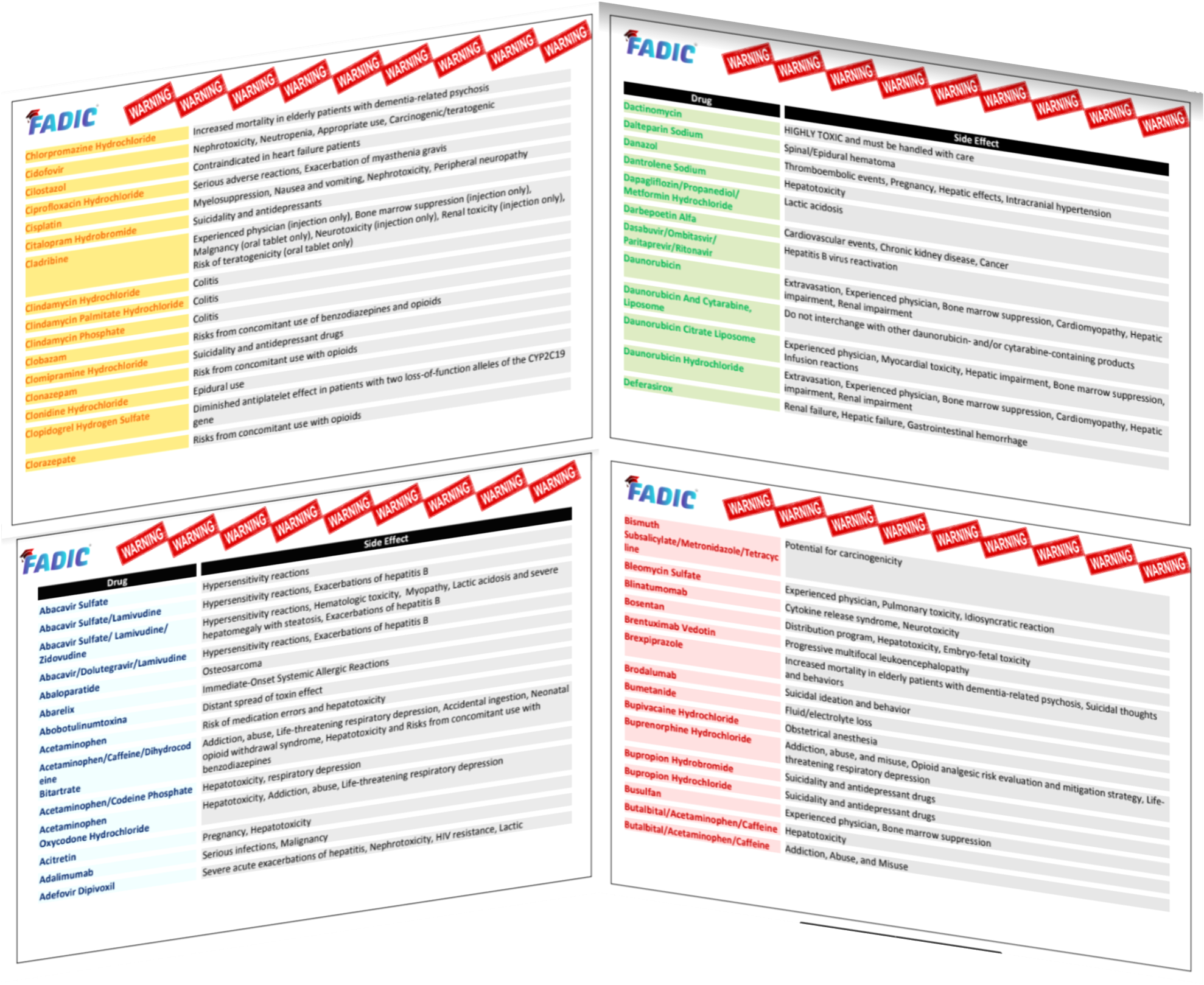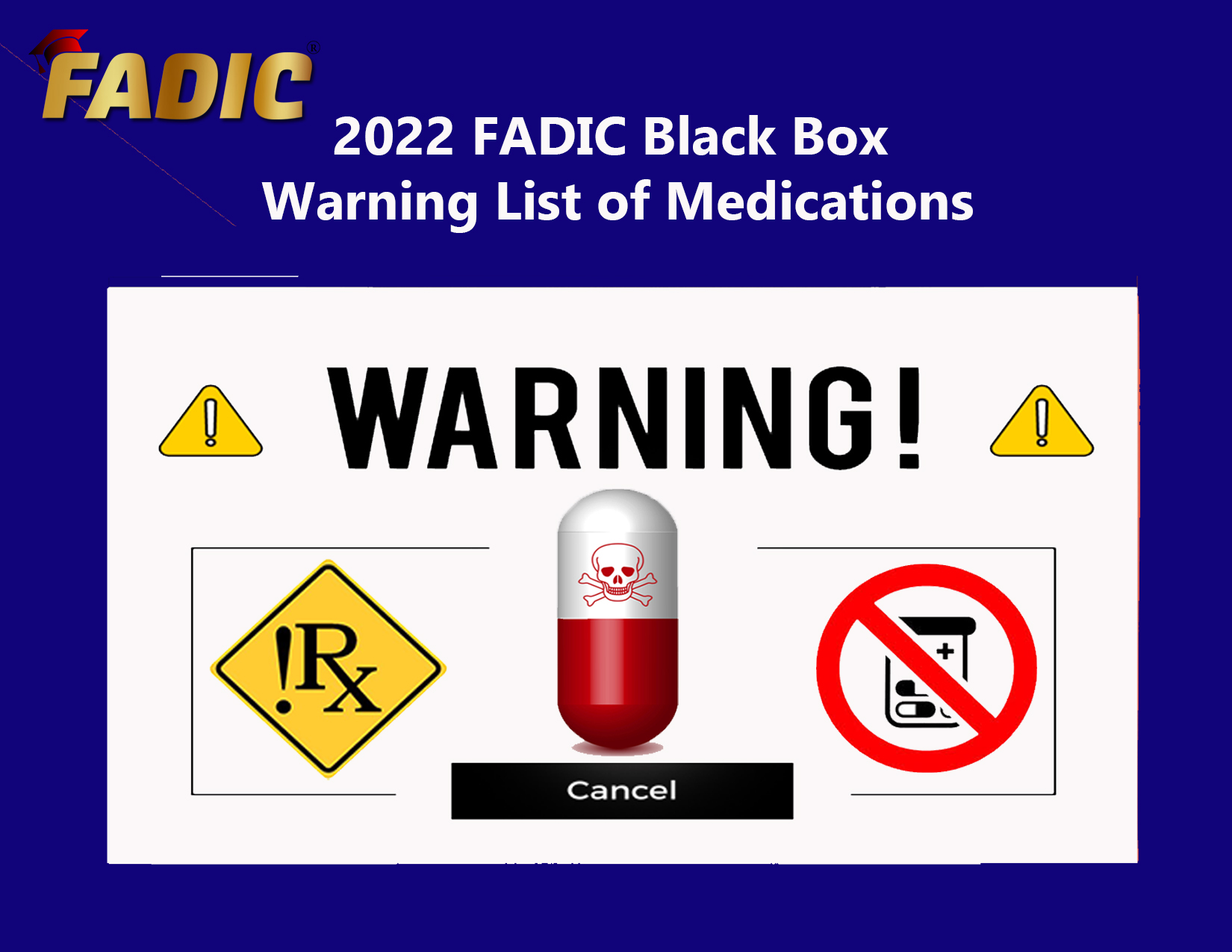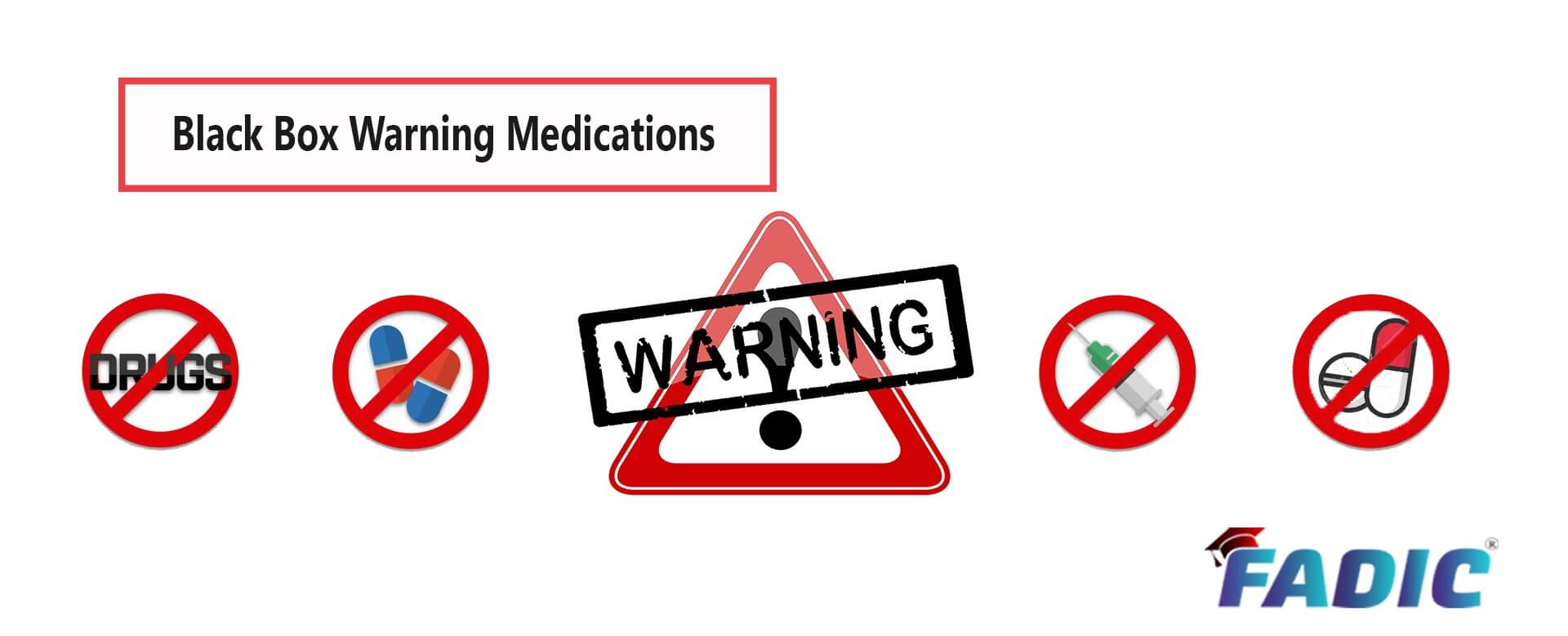What Does the Blue Box for Medicine Disposal Look Like
Black Box Warning 2022 List of Medications from FADIC
Black Box Warning 2022 List of Medications from FADIC
1- What is black Box warning? 💊
2- Black Box and Off-Label Uses 💊
3- When the FDA Requires One 💊
4- Importance of Black Box Warning 💊
5- Examples of black box warnings 💊
6- Download Now FADIC Black Box Warning List of Medications From FADIC 💊
7- Conclusion 💊
What is black Box warning?
- Black box warnings are the most serious warnings imposed by the Food and Drug Administration (FDA) for prescription medications.
- Additionally, It highlight potentially fatal, life-threatening, or disabling adverse effects for prescription drugs.
- In addition, black box warnings include information regarding restriction of use and/or distribution of medications.
- Moreover, FDA mandates that black box warnings separated and highlighted from the other text in the package insert and characterized with a black box border.
Six criteria appeared to influence the FDA's decision on black box warning for drug products:
- Identify a drug-associated adverse event prevented through monitoring and intervention
- Identify specific patients for whom the treatment is particularly dangerous
- Advise that the risks of treatment may outweigh the benefits
- Identify a potentially harmful drug interaction or describe critical dosing information
- State that the drug administered only by a specially trained health care practitioner or in a special setting
- Caution that the method of drug administration requires exceptional care.
- Prior to a drug being launched, the FDA reviews and carefully scrutinizes adverse events that occur during the research phase.
- An adverse event is any undesirable experience a patient use a medical product.
- Serious adverse events, which are the ones FDA interested in, include death, life-threatening situations.
- Initial or prolonged hospitalization, and situations requiring medical intervention to prevent permanent damage, disability, and congenital anomaly.
- Congenital anomalies include birth defects, miscarriage and stillbirth, or birth with cancer or some other serious disease.
- If the drug trials report serious and unexpected drug events, then the FDA will make a decision to continue the studies and/or approve the drug.
- Many times serious or life-threatening adverse events (reported through adverse drug reports (ADRs) discovered only after a drug on the market for years.
Black Box and Off-Label Uses:
- These serious side effects surface as the drug more widely used or prescribed for off-label uses.
- The research studies performed prior to approval may not find the adverse effects that occur long after the drug discontinued or that occur only after years of continuous or chronic use.
- In one study, only half of newly discovered serious ADRs identified and documented within 7 years after drug approval.
- These risks may appear to be life-threatening, or they appear to be less serious.
- At this point, the FDA and the drug's sponsor will review new, emerging safety information to determine if there is a true safety issue related to the drug and if regulatory or other action needed.
Once an adverse event or product problem is identified, the FDA can take any of the following actions:
- Labeling Changes — Adverse events often prompt the FDA to require the manufacturer to add new information to the product's package insert.
- Boxed Warnings — Reserved for the most serious adverse events.
The FDA require that warnings be placed in a prominent position on the product's packaging to ensure its continued safe use. - Product Recalls and Withdrawals — are among the most serious actions the FDA can advise a company to take.
- Recalls involve the firm's removal of a product from the market and may require taking the product off the market permanently.
- Medical and Safety Alerts — used to provide important safety information about a product to health professionals, trade, and media organizations.
When the FDA Requires One
The FDA requires a black box warning for one of the following situations:
- Firstly, the medication cause serious undesirable effects (such as a fatal, life-threatening or permanently disabling adverse reaction).
- Secondly, compared with the potential benefit from the drug. Depending on your health condition, you and your physician would need to decide whether the potential benefit of taking the drug is worth the risk.
- Then, A serious adverse reaction can be prevented, reduced in frequency, or reduced in severity by proper use of the drug.
- Finally, for example, a medication may be safe to use in adults, but not in children.
Or, the drug may be safe to use in adult women who are not pregnant.
Importance of Black Box Warning:
- Firstly, the intent of a black-box warning is to provide a clarion signal to physicians and patients to consider the adverse event.
- In addition to its magnitude in their benefit-risk analysis prior to prescribing the drug to which attached.
- Black-box warnings may be drug-specific, as in the case of transdermal fentanyl, which a black-box warning addressing respiratory depression.
- Black-box warnings added to entire classes of drugs.
- For example, in 2008, a black-box warning added to all fluoroquinolone antibiotics, warning of increased tendon injuries in older patients, those on steroids, and transplant recipients.
Examples of black box warnings:
- Moreover, FDA requires a black box warning on all antidepressants because of an increased risk of suicidal thinking.
- In addition to behaviour in young adults aged between 18 and 24 during initial treatment generally the first one to two months of therapy.
This black box warning initially created in 2004 and expanded to cover patients aged younger than 24 years in 2007.
- Angiotensin-receptor blockers (ARBs like enalapril or losartan) present risk to the foetus during gestation.
- Thus, these antihypertensive medications avoided during pregnancy.
- For example, medications such as ARBS, angiotensin-converting enzyme inhibitors (ACE inhibitors or "statins") are antihypertensive medications.
- They are also dangerous to the developing foetus and should be avoided during pregnancy.
- For example, Aspirin can cause Reye's syndrome in children. Reye's syndrome is a rare syndrome that causes swelling of the liver or brain.
In addition to, the development of Reye's syndrome in children linked to the administration of aspirin in children who recover from chicken pox or the flu.
The administration of aspirin to children considered by a physician. Additionally, aspirin has a more general black box warning that warns of allergy.
- Oral contraceptive pills warn of increased risk of stroke in women aged 35 years and older.
- Ibuprofen and other nonsteroidal anti-inflammatory drugs (NSAIDs) sport black box warnings linking them to gastrointestinal bleeding and ulcers as well as haemorrhagic stroke (brain bleeds).
- Fluoroquinolone Antibiotics.
FDA Warnings !!
- According to the FDA, people taking a fluoroquinolone antibiotic increased risk of tendinitis and tendon rupture, a serious injury that could cause permanent disability.
- The FDA warning includes Cipro (ciprofloxacin), Levaquin (levofloxacin), Avelox (moxifloxacin) and other medications containing fluoroquinolone. (Warning issued July 2008.
Diabetes Medications and Black Box Warning !!
- According to the FDA, people with diabetes taking Avandia (rosiglitazone) increase risk of heart failure or heart attack.
- If they already have heart disease or at high risk of suffering a heart attack. (Warning issued November 2007.)

Examples:
1- Abacavir Sulfate
2- Abacavir Sulfate/Lamivudine
3- Abacavir Sulfate/Lamivudine/Zidovudine
4- Abacavir/Dolutegravir/Lamivudine
5- Abaloparatide
6- Abarelix
7- Abobotulinumtoxina
8- Acetaminophen
9- Acetaminophen/Caffeine/Dihydrocodeine
10-Bitartrate

D ownload Now
The Whole Book of 2022 FADIC Black Box Warning List of Medications From FADIC Store, from this LINK.

Conclusion:
- Black box warnings are the most serious warnings imposed by the Food and Drug Administration (FDA) for prescription medications.
- Moreover, FDA highlights potentially fatal, life-threatening, or disabling adverse effects for prescription drugs.
- Most drugs, prescriptions and non-prescription, risk associated with their use. Prescribers must consider these risks and the drug's benefits when determining drug therapy for the patient.

Relate Recommended Reading:
- Register Now in FADIC 2021 Daily Pharmacy E-News (FNN)
- You can download the List of Medication with Black Box Warning
- Buy Now the FADIC Drug Information Flash E-Cards
- Download FADIC Clinical Pharmacology Cards Quick Guide
- Visit FADIC CPD Accredited Courses, Mini-Courses, Workshops and Schools
- Visit FADIC Nutritional Centre | Minerals and Vitamins
Copyright ©: All content on FADIC Website, including medical opinion and any other health-related information, and drug Informtation is for informational purposes only
Source: https://fadic.net/black-box-warning-list/

0 Response to "What Does the Blue Box for Medicine Disposal Look Like"
ارسال یک نظر